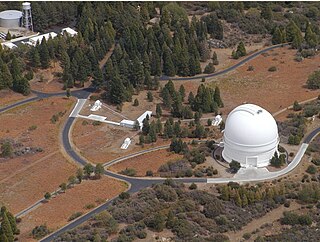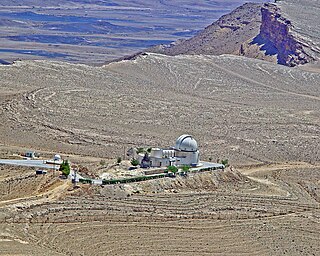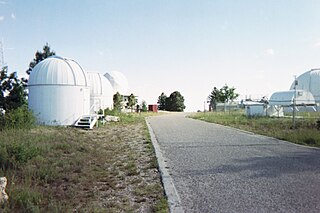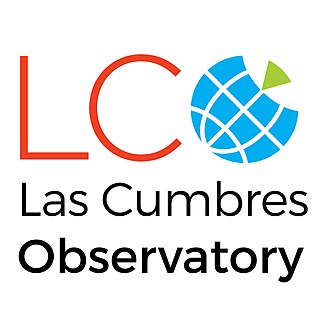
Palomar Observatory is an astronomical research observatory in the Palomar Mountains of San Diego County, California, United States. It is owned and operated by the California Institute of Technology (Caltech). Research time at the observatory is granted to Caltech and its research partners, which include the Jet Propulsion Laboratory (JPL), Yale University, and the National Astronomical Observatories of China.

McDonald Observatory is an astronomical observatory located near unincorporated community of Fort Davis in Jeff Davis County, Texas, United States. The facility is located on Mount Locke in the Davis Mountains of West Texas, with additional facilities on Mount Fowlkes, approximately 1.3 kilometers (0.81 mi) to the northeast. The observatory is part of The University of Texas at Austin. It is an organized research unit of the College of Natural Sciences.

The Apache Point Observatory is an astronomical observatory located in the Sacramento Mountains in Sunspot, New Mexico, United States, approximately 18 miles (29 km) south of Cloudcroft. The observatory is operated by New Mexico State University (NMSU) and owned by the Astrophysical Research Consortium (ARC). Access to the telescopes and buildings is private and restricted.

The Cerro Tololo Inter-American Observatory (CTIO) is an astronomical observatory located on the summit of Mt. Cerro Tololo in the Coquimbo Region of northern Chile, with additional facilities located on Mt. Cerro Pachón about 10 kilometres (6.2 mi) to the southeast. It is approximately 80 kilometres (50 mi) east of La Serena, where support facilities are located. The principal telescopes at CTIO are the 4 m Víctor M. Blanco Telescope, named after Puerto Rican astronomer Víctor Manuel Blanco, and the 4.1 m Southern Astrophysical Research Telescope, which is situated on Cerro Pachón. Other telescopes on Cerro Tololo include the 1.5 m, 1.3 m, 1.0 m, and 0.9 m telescopes operated by the SMARTS consortium. CTIO also hosts other research projects, such as PROMPT, WHAM, and LCOGTN, providing a platform for access to the southern hemisphere for U.S. and worldwide scientific research.

A robotic telescope is an astronomical telescope and detector system that makes observations without the intervention of a human. In astronomical disciplines, a telescope qualifies as robotic if it makes those observations without being operated by a human, even if a human has to initiate the observations at the beginning of the night or end them in the morning. It may have software agents using artificial intelligence that assist in various ways such as automatic scheduling. A robotic telescope is distinct from a remote telescope, though an instrument can be both robotic and remote.

La Silla Observatory is an astronomical observatory in Chile with three telescopes built and operated by the European Southern Observatory (ESO). Several other telescopes are also located at the site and are partly maintained by ESO. The observatory is one of the largest in the Southern Hemisphere and was the first in Chile to be used by ESO.

Siding Spring Observatory near Coonabarabran, New South Wales, Australia, part of the Research School of Astronomy & Astrophysics (RSAA) at the Australian National University (ANU), incorporates the Anglo-Australian Telescope along with a collection of other telescopes owned by the Australian National University, the University of New South Wales, and other institutions. The observatory is situated 1,165 metres (3,822 ft) above sea level in the Warrumbungle National Park on Mount Woorat, also known as Siding Spring Mountain. Siding Spring Observatory is owned by the Australian National University (ANU) and is part of the Mount Stromlo and Siding Spring Observatories research school.

The Haleakalā Observatory, also known as the Haleakalā High Altitude Observatory Site, is Hawaii's first astronomical research observatory. It is located on the island of Maui and is owned by the Institute for Astronomy of the University of Hawaiʻi, which operates some of the facilities on the site and leases portions to other organizations. Tenants include the Air Force Research Laboratory (AFRL) and the Las Cumbres Observatory Global Telescope Network (LCOGTN). At over 3,050 meters (10,010 ft) in elevation, the summit of Haleakalā is above one third of the Earth's troposphere and has excellent astronomical seeing conditions.

Teide Observatory, IAU code 954, is an astronomical observatory on Mount Teide at 2,390 metres (7,840 ft), located on Tenerife, Spain. It has been operated by the Instituto de Astrofísica de Canarias since its inauguration in 1964. It became one of the first major international observatories, attracting telescopes from different countries around the world because of the good astronomical seeing conditions. Later, the emphasis for optical telescopes shifted more towards Roque de los Muchachos Observatory on La Palma.

The South African Astronomical Observatory (SAAO) is the national centre for optical and infrared astronomy in South Africa. It was established in 1972. The observatory is run by the National Research Foundation of South Africa. The facility's function is to conduct research in astronomy and astrophysics. The primary telescopes are located in Sutherland, which is 370 kilometres (230 mi) from Observatory, Cape Town, where the headquarters is located.

The Florence and George Wise Observatory is an astronomical observatory owned and operated by Tel Aviv University. It is located 5 kilometers west of the town of Mitzpe Ramon in the Negev desert near the edge of the Ramon Crater, and it is the only professional astronomical observatory in Israel.

The Royal Observatory, Edinburgh (ROE) is an astronomical institution located on Blackford Hill in Edinburgh. The site is owned by the Science and Technology Facilities Council (STFC). The ROE comprises the UK Astronomy Technology Centre (UK ATC) of STFC, the Institute for Astronomy of the School of Physics and Astronomy of the University of Edinburgh, and the ROE Visitor Centre.

The Warner and Swasey Observatory is the astronomical observatory of Case Western Reserve University. Named after Worcester R. Warner and Ambrose Swasey, who built it at the beginning of the 20th century, it was initially located on Taylor Road in East Cleveland, Ohio, USA. The observatory, which at that time housed a 9.5-inch (24 cm) refractor, was donated in 1919 to the Case School of Applied Science. The newer 24-inch (61 cm) Burrell Schmidt telescope was built in 1939.
Moore Observatory is an astronomical observatory owned and operated by University of Louisville. It is located on the Horner Wildlife Refuge in Oldham County, Kentucky (USA) approximately 20 kilometers (12 mi) northeast of Louisville. It opened in 1978, and was dedicated to Walter Lee Moore, a Professor of Mathematics at U of L from 1929 to 1967.

Mount Lemmon Observatory (MLO), also known as the Mount Lemmon Infrared Observatory, is an astronomical observatory located on Mount Lemmon in the Santa Catalina Mountains approximately 28 kilometers northeast of Tucson, Arizona (US). The site in the Coronado National Forest is used with special permission from the U.S. Forest Service by the University of Arizona's Steward Observatory, and contains a number of independently managed telescopes.

Las Cumbres Observatory (LCO) is a network of astronomical observatories run by a non-profit private operating foundation directed by the technologist Wayne Rosing. Its offices are in Goleta, California. The telescopes are located at both northern and southern hemisphere sites distributed in longitude around the Earth. For some astronomical objects, the longitudinal spacing of telescopes allows continuous observations over 24 hours or longer. The operating network currently consists of two 2 meter telescopes, nine 1 meter telescopes, and seven 40 cm telescopes, placed at six astronomical observatories. The network operates as a single, integrated, observing facility, using a software scheduler that continuously optimizes the planned observing schedule of each individual telescope.

Leibniz Institute for Astrophysics Potsdam (AIP) is a German research institute. It is the successor of the Berlin Observatory founded in 1700 and of the Astrophysical Observatory Potsdam (AOP) founded in 1874. The latter was the world's first observatory to emphasize explicitly the research area of astrophysics. The AIP was founded in 1992, in a re-structuring following the German reunification.

The Wyoming Infrared Observatory (WIRO) is an astronomical observatory owned and operated by the University of Wyoming. It is located on Jelm Mountain, 25 miles (40 km) southwest of Laramie, Wyoming, U.S. It was founded in 1975, and observations began at the site in 1977. Recent research performed at WIRO includes searching for runaway stars, monitoring short-term variations in blazars, and monitoring massive binary stars.

The Belgrade Observatory is an astronomical observatory located in the Zvezdara Forest in the eastern part of Belgrade, Serbia.

The Embry–Riddle Observatory is an astronomical observatory owned and operated by Embry-Riddle Aeronautical University, Daytona Beach. Hosting an array of optical instruments, this observatory is situated on the roof of the College of Arts and Sciences building in Daytona Beach, Florida.




















